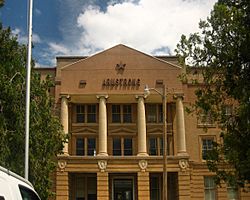Armstrong County, Texas facts for kids
Quick facts for kids
Armstrong County
|
|
|---|---|

The Armstrong County Courthouse in Claude
|
|

Location within the U.S. state of Texas
|
|
 Texas's location within the U.S. |
|
| Country | |
| State | |
| Founded | 1890 |
| Seat | Claude |
| Largest city | Claude |
| Area | |
| • Total | 914 sq mi (2,370 km2) |
| • Land | 909 sq mi (2,350 km2) |
| • Water | 4.7 sq mi (12 km2) 0.5% |
| Population
(2020)
|
|
| • Total | 1,848 |
| • Density | 2.0219/sq mi (0.7807/km2) |
| Time zone | UTC−6 (Central) |
| • Summer (DST) | UTC−5 (CDT) |
| Congressional district | 13th |
Armstrong County is a small county in the U.S. state of Texas. It is located in the Texas Panhandle, which is the northern part of the state that looks like a panhandle. The main town and county seat is Claude.
In 2020, about 1,848 people lived in Armstrong County. It is part of the larger Amarillo metropolitan area, which is a group of cities and towns connected by jobs and daily life.
The county was officially created in 1876 and started operating in 1890. It was named after one of the early families who settled in Texas, called Armstrong.
Contents
History of Armstrong County
Early People and Tribes
Long ago, around 10,000 BC, the first people known as Paleo-Indians lived in this area. Later, Apachean groups roamed the county. Around the year 1700, the Comanche tribe became the main group.
The United States Army fought the Comanches in the Red River War of 1874. After this, other tribes like the Kiowa and Cheyenne also lived here.
How the County Grew
In 1876, the Texas Legislature officially created Armstrong County. It was formed from parts of another county called Bexar County. The county officially started to operate in 1890, and Claude became its main town, or county seat.
In 1876, a man named Charles Goodnight brought 1,600 cattle into the Palo Duro Canyon. He and John George Adair started a huge ranch called the JA Ranch. This ranch covered over a million acres across Armstrong County and five other counties. For many years, most of the land in the county was used for ranching.
In 1887, the JA Ranch was divided. This led to the creation of a new town called Goodnight, which was a stop for the Fort Worth and Denver City Railway. Another landowner, Robert E. Montgomery, planned a town called Washburn, named after a railroad executive.
By 1888, the railroad made Washburn a very busy town. In the same year, Armstrong City was renamed Claude to honor a railroad engineer named Claude Ayers. In 1890, Claude won the competition to become the county seat.
At the start of the 1900s, farmers began to grow cotton and wheat. However, ranching remained the most important industry in the county. Even in 2005, about 68% of the land was still used for ranches.
Geography of Armstrong County
Armstrong County covers about 914 square miles. Only a small part, about 4.7 square miles, is covered by water.
Main Roads
Neighboring Counties
Armstrong County shares borders with these counties:
- Carson County (to the north)
- Gray County (to the northeast)
- Donley County (to the east)
- Briscoe County (to the south)
- Swisher County (to the southwest)
- Randall County (to the west)
- Potter County (to the northwest)
People of Armstrong County
In 2020, the population of Armstrong County was 1,848 people. Most people in the county are White. There are also smaller groups of Black or African American, Native American, Asian, and people of mixed races. About 7.79% of the population is Hispanic or Latino.
The average age in the county in 2000 was 41 years old.
Education in Armstrong County
Most of Armstrong County is served by the Claude Independent School District.
Small parts of the county are also served by school districts from neighboring counties. These include the Clarendon Consolidated Independent School District, Groom Independent School District, and Happy Independent School District.
Towns and Communities
City
- Claude (This is the county seat, the main town where the county government is located.)
Other Communities
These are smaller communities that are not officially cities:
See also
 In Spanish: Condado de Armstrong (Texas) para niños
In Spanish: Condado de Armstrong (Texas) para niños

